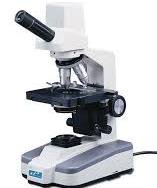Len’s power is defined as the reciprocal of its focal length f, expressed in meters. The formula is P=1/f.
P = \frac{1}{f}P=f1.
For example, a lens with a focal length of 0.5 meters has a power of 10.5=2\frac{1}{0.5} = 20.51=2 D.
Series Combination: When lenses are placed in series (one after the other), the total power P is the sum of the individual powers of the lenses. If you have two lenses with one having power P1 and the other one having power P2; the total power P due to the combination is p1 +p2
Example: If you have a +2 D lens and a +3 D lens in series, the total power is +2++3=+5+2 + +3 = +5+2++3=+5 D.
In eyeglasses or contact lenses, combining different lenses allows for precise correction of vision by targeting specific focal lengths needed to correct visual impairments.
In devices like microscopes and telescopes, combining lenses helps achieve desired magnification and image clarity.

Len’s power
Understanding the power of thin lenses and how to combine them is fundamental in designing optical systems and correcting visual errors.
The degree to which a lens deviate light is called the optical power.
Optical power measures how sharp the lens bends light that passes through it . Optical power P is given by P=1/f where f is the focal length of the lens. From the equation, one can see that the shorter the focal length, the higher the optical power. The unit for optical power is m-1 .
m-1 is known as dioptre (D)
Len’s Combination
If an object is placed infront of a combination of two or more lenses, it’s image in the first lens becomes the object for the second lens which in turn produces another image. If there is a third lens, the second image becomes it’s object.
One application of the Len’s combination is the compound microscope which combines two converging lenses of short focal length. In the microscope, the lens near the object is known as the objective lens and one near the eye is referred to as the eyepiece. Eyepiece has longer focal length compared to objective lens.

The object to be viewed is placed between Fo and 2Fo of the objective lens so that a real inverted and magnified image is formed. This image is infront of the eyepiece and will act as an object to it. The eyepiece is adjusted so that this image falls between it’s principal focus Fo and itself so that a virtual but magnified image is obtained. The eyepiece therefore acts as a magnifying glass and produces a final image that is greatly magnified as in the figure above
Compound Microscope magnification
Magnification of objective lens mo = u/v where v is the distance of the first image from the objective lens and u the object distance. Taking fo as the focal length of the object lens, then from the lens formula:
multiplying through by v;
1 + v/u = v/fo
substituting mo = u/v; we have
1 + mo = v/fo and so mo = v/fo -1
similarly, magnification me produced by the eyepiece will be given as:
me = D/fe -1
where D is the distance of first image from the lens.
Total magnification produced by this lens arrangement is the product of mo and me
That is, Total magnification = ( D/fe -1)(v/fo -1 )
Related Topics
- Introduction to thin lenses
- Vocabulary of thin lenses
- Image formation by Thin lenses
- Linear Magnification
- Drawing Ray diagrams
- Image formation by thin lenses
- Focal Length by non-parallax technique
- The lens formula


Leave a Reply